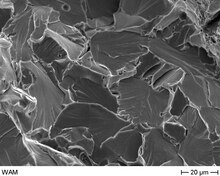Mixed fraction
In the case of a mixed fracture , sliding fracture and split fracture exist side by side.
They can be distinguished by their different fracture appearance. Matt surfaces indicate a sliding fracture , whereas the fissure fracture surface (crystalline) shines. Mixed fractures usually only occur in steels with a body-centered cubic lattice structure and low strength.
Macroscopic fracture appearance

A sliding fracture or a split fracture can be distinguished with the naked eye by the appearance of the fracture .
Is a mixed fraction before, appear in the mixed fracture surface Gleitbruchanteile matt and cleavage fracture shares crystalline [glossy].
In the figure on the right, a mixed fracture is viewed under the stereo microscope.
Most of the surface area of the sample appears matt , this area is broken in a ductile manner . It lies under the sample surface.
The shiny area in the middle appears crystalline, it is broken in a brittle manner and indicates a crack .
By measuring the crystalline fraction, the brittle fraction in the fracture surface can be determined. Adding 100% results in the sliding fracture share (figure on the right).
| The product of A and B gives the crack area. If this is related to the entire fracture surface, the result is the proportion of the fissure fracture surface. Adding 100% results in the sliding fracture share.
A and B must be measured to within 0.5 mm. See also Table C.1 from the DIN EN ISO 1481 standard ( Charpy notch impact test ) |
|---|
Microscopic fracture appearance

Honeycomb fracture = ductile fracture = sliding fracture
|
In the case of a mixed fracture, split fracture (surface created by splitting the cages along split planes) and sliding fracture ( honeycomb-like surface created by deformation) occur side by side.
Test procedure
Only ferritic steels show a temperature-dependent transition between and gap fracture and sliding fracture . When testing these materials , the aim is to determine the temperature range in which the transition from sliding fracture to split fracture occurs. This area is also called the steep drop .
A Charpy impact test is carried out, which is specified in DIN EN ISO 1481 .
Depending on which steel is present, it can perform different impact work or absorb energy. This can be seen schematically in the following figures.
The figure on the left compares the impact energy as a function of temperature between a ferritic and an austenitic steel. The figure on the right shows the impact work of ferritic steels as a function of the carbon content (whereby the C content also influences the strength).
Influencing factors

Various lattice structures (and strength) of various steels depending on the impact energy KV and temperature.
|

Influence of the carbon content on the impact energy KV
|
Various factors influence the appearance of the break. These include the lattice structure and the carbon content . The first graphic shows the influence of the lattice structure on the impact work KV. In the following figure, the impact energy is determined by the carbon content.
Other types of fractures
- Fatigue fracture (also fatigue fracture)
- Brittle fracture
- Deformation fracture
Individual evidence
- ↑ Wolfgang Bergmann: Materials Technology 1 . Hanser, S. 152 .
- ^ William D. Callister and David D. Rethwisch: Materials Science and Material Technology - An Introduction . Ed .: Michael Scheffler. 1st edition 2013. Wiley-VCH, Weinheim, Germany 2013, ISBN 978-3-527-33007-2 , pp. 230 (Fig.8.15).
- ↑ Wolfgang Bergmann: Materials Technology 1 . Hanser, S. 160 (Fig. B.2-48).
- ↑ DIN German Institute for Standardization e. V .: Metallic materials - Charpy impact test - Part 1: Test method (ISO / DIS 148-1: 2015) . Ed .: DIN German Institute for Standardization e. V. Berlin 2015, p. 21 .



